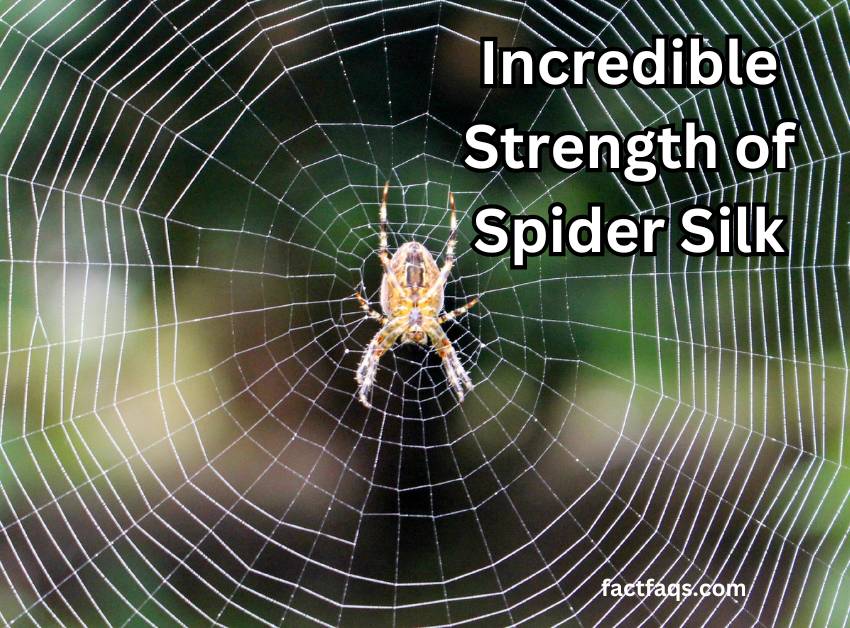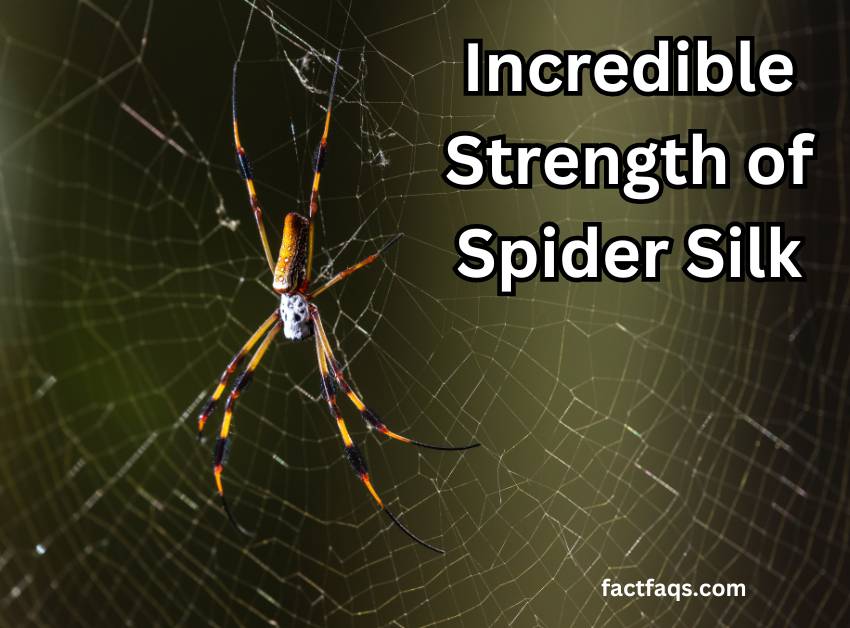Spider silk is incredibly strong, even surpassing the strength of steel. This remarkable strength has gained significant attention and admiration from scientists and engineers alike.
Spider silk is not only one of nature’s most fascinating creations but is also a material with awe-inspiring strength. It is widely acknowledged that spider silk is stronger than steel, uniquely combining toughness and flexibility. This extraordinary strength has captivated the attention of researchers and designers across various fields, including engineering and biological sciences.
Understanding the incredible properties of spider silk has the potential to revolutionize the development of materials, from protective gear to medical devices. We delve into the exceptional strength of spider silk, exploring its composition, characteristics, and the various applications that could benefit from its remarkable properties. Join us on an intriguing journey into the astonishing world of spider silk.
What Makes Spider Silk So Strong?
Spider silk exhibits incredible strength, surpassing even that of steel. Its unique composition and molecular structure contribute to its remarkable toughness and durability, making it a truly exceptional material in the natural world.

Spider silk is known for its incredible strength, often surpassing that of steel. This strength can be attributed to several unique factors, including the spider’s remarkable molecular structure and the specific sequences of proteins found in spider silk.
Unique Molecular Structure
- Spider silk consists of long chains of proteins called fibroins.
- These fibroins form a complex molecular structure with intertwining strands.
- The arrangement of these strands creates a flexible yet resilient material.
- The unique molecular structure of spider silk allows it to absorb and distribute force evenly.
Spider Silk Vs. Steel: A Comparative Analysis
Spider silk’s strength is often compared to that of steel, and it holds up impressively in this comparison.
- Spider silk is incredibly lightweight, outperforming steel in terms of weight-to-strength ratio.
- It has been estimated that spider silk could potentially be five times stronger than steel of the same diameter.
- Despite its remarkable strength, spider silk is also highly elastic, making it tougher than most materials.
The Role Of Protein Sequences In Strength
The specific protein sequences found in spider silk contribute significantly to its strength and other desirable properties.
- Spider silk proteins contain repetitive amino acid sequences.
- These repetitive sequences allow for the formation of strong and orderly structures within the silk.
- Certain amino acid residues, such as proline and glycine, are particularly abundant in spider silk proteins.
- These specific amino acids enable the silk to stretch and absorb energy before breaking.
Spider silk’s incredible strength stems from its unique molecular structure and the special protein sequences it contains. With its lightweight nature and impressive strength-to-weight ratio, spider silk proves to be a formidable material, rivaling the durability of steel. By understanding the factors that contribute to its strength, scientists can harness the potential of spider silk in various applications, from engineering to medical advancements.
Industrial Applications Of Spider Silk
Spider silk is renowned for its incredible strength, surpassing that of steel. With industrial applications, this natural marvel is being utilized in areas like bulletproof vests, surgical sutures, and even lightweight yet tough fabrics for aerospace engineering. Discover the limitless possibilities of this remarkable material.
Spider silk is not only a remarkable natural material but also possesses incredible strength that surpasses that of steel. Due to its impressive properties, spider silk has a wide range of industrial applications. In this section, we will explore some of the key uses of spider silk in various industries.
Next-Generation Bulletproof Vests:
- Spider silk, with its exceptional strength-to-weight ratio, holds great potential in the development of next-generation bulletproof vests.
- Bulletproof vests made from spider silk fibers are lighter and more flexible compared to traditional vests, providing enhanced comfort for the wearer.
- The remarkable toughness of spider silk enables it to absorb and disperse the impact of bullets effectively, offering superior protection against ballistic threats.
- These vests can potentially revolutionize the personal safety and security of military personnel, law enforcement officers, and civilians in high-threat environments.
Lightweight Yet Strong Textiles For Aerospace Industry:
- Spider silk’s strength and lightness make it an ideal candidate for aerospace applications, including the development of lightweight yet strong textiles.
- Fabrics made from spider silk fibers can offer improved payload capacity for spacecraft, as they significantly reduce the overall weight of structural components.
- The exceptional resistance and durability of spider silk make it suitable for withstanding the extreme conditions experienced in space, such as high-temperature fluctuations and radiation exposure.
- These textiles could also be used for creating parachute materials, space suits, and other space exploration equipment, contributing to advancements in aerospace technology.
Enhanced Surgical Materials For the Medical Field:
- Spider silk’s biocompatibility and strength make it valuable for the development of enhanced surgical materials in the medical field.
- Sutures made from spider silk offer improved wound closure, as they are less likely to cause inflammation and allergic reactions compared to traditional sutures.
- The natural degradation properties of spider silk enable the sutures to gradually break down over time, reducing the need for additional surgeries for suture removal.
- Spider silk-based materials can also be utilized in the production of tissue scaffolds, promoting cell growth and tissue regeneration for medical purposes.
Spider silk’s incredible strength opens up a world of possibilities in numerous industries. From next-generation bulletproof vests to lightweight textiles for aerospace applications, and enhanced surgical materials for the medical field, the potential applications of spider silk are vast and exciting.
As researchers continue to unlock the secrets of this remarkable material, we can look forward to witnessing even more innovative uses in the future.
Harnessing The Potential: Advances In Spider Silk Production
Advancements in spider silk production have unlocked its incredible strength, surpassing even that of steel. This natural material offers limitless potential for various industries seeking stronger and more sustainable alternatives.
The Incredible Strength Of Spider Silk: Stronger Than Steel
Spider silk is a fascinating material with incredible strength and durability. In fact, it is considered to be stronger than steel, making it a sought-after material for various applications. Harnessing the potential of spider silk production has led to remarkable advancements in the field.
Let’s explore some of the key developments in this exciting domain.
Recombinant DNA Technology: A Game-Changer For Spider Silk Production
- Recombinant DNA technology has revolutionized spider silk production.
- Scientists have successfully inserted silk protein genes into other organisms like bacteria, yeast, and even silkworms.
- By doing so, they can cost-effectively mass-produce spider silk proteins.
- This method allows for the production of large quantities of spider silk, which was previously extremely difficult.
Synthetic Spider Silk: A Promising Alternative
- In addition to producing spider silk through living organisms, synthetic spider silk is also being explored.
- Synthetic spider silk is created by mimicking the genetic sequences of spider silk proteins in a laboratory setting.
- This approach offers advantages such as increased control over the silk’s properties and scalability.
- Researchers are continuously improving the production and quality of synthetic spider silk materials, making them a viable alternative to natural silk.
Challenges In Scaling Up Production
- While advances have been made in spider silk production, scaling up the process remains a challenge.
- One of the main hurdles is the cost-effectiveness of large-scale production.
- Another challenge lies in ensuring that the produced silk mimics the properties of natural spider silk.
- Controlling the structure and performance of the silk at a larger scale is an ongoing area of research.
- Nonetheless, researchers are constantly exploring new methods and techniques to overcome these challenges.
Spider silk possesses extraordinary strength and versatility, making it a valuable resource for various industries. With the advent of recombinant DNA technology and the emergence of synthetic alternatives, the potential applications of spider silk are expanding rapidly. As scientists continue to refine production methods and overcome challenges, we can look forward to a future where spider silk becomes a commonplace material, revolutionizing industries such as medicine, textiles, and beyond.
Frequently Asked Questions Of The Incredible Strength Of Spider Silk: Stronger Than Steel
Is Spider Silk Stronger Than Steel?
Yes, spider silk is stronger than steel. Pound for pound, spider silk is one of the strongest materials on Earth. Its incredible strength and toughness make it even stronger than steel.
Why Is Spider Silk So Strong?
Spider silk’s strength comes from its unique molecular structure. It is made up of protein chains that are arranged in a way that provides exceptional strength and flexibility. Its combination of high tensile strength and elasticity allows it to withstand a lot of force without breaking.
How Is Spider Silk Used In Technology?
Spider silk has many potential applications in technology. It can be used to make strong and lightweight materials for construction, aerospace, and protective gear. It can also be used in biomedical applications like sutures and artificial tendons. Researchers are constantly exploring new ways to harness the unique properties of spider silk.
What Are Some Other Advantages Of Spider Silk?
Besides its strength, spider silk has other advantages. It is biodegradable, non-toxic, and renewable. It is also highly flexible and can be stretched without losing its strength. These qualities make spider silk an attractive material for sustainable and eco-friendly solutions.
Conclusion
The incredible strength of spider silk has been proven to be stronger than steel. This extraordinary material has captured the attention of scientists and engineers around the world, as its potential applications are virtually limitless. From bulletproof vests to artificial tendons, spider silk can revolutionize various industries.
Not only is it incredibly strong, but it is also lightweight, flexible, and biodegradable, making it an eco-friendly alternative to traditional materials. The unique properties of spider silk, including its impressive tensile strength and ability to withstand extreme conditions, make it an invaluable resource for the development of innovative products.
As researchers continue to explore the secrets of spider silk production and harness its strength, exciting advancements are bound to emerge. With this groundbreaking material at our disposal, we may see a future where spider silk becomes a cornerstone of technological innovation and a symbol of the remarkable potential that nature holds.
